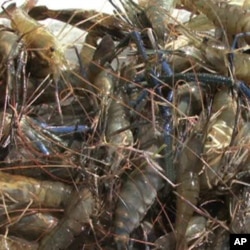It’s harvest time in Tennessee, but the Corbin family matriarch isn’t gearing up to harvest the typical corn, cotton, or soybeans.
Jane Corbin and her sons are draining a pond to gather the fresh water shrimp, or prawns, they’ve been raising for the past five months. Corbin says she got into aquaculture, a segment of the agriculture industry valued at $70 billion a year, almost by accident.
“I had never met anyone who had done this and I’d never seen a freshwater prawn," Corbin says, "but I had read about it and I just thought it sounded interesting.”
Curiosity may have led Corbin, who also grows tobacco, into aquaculture in the late 1990s, but other farmers in the American South gave it a try because state and federal agencies were encouraging them to switch from tobacco.
Although it has been a staple of American farming since the nation’s colonial days, tobacco has been in steady decline in recent years.
“It was advertised as an alternative to your tobacco crop as far as your income was concerned," Corbin says, referring to prawn farming."That did not ring true. That wasn’t why I got into it, of course, but a lot of people did and they saw that that was not a fact.”
Tony Johnston, who teaches agriculture and food science at nearby Middle Tennessee State University, says the challenge in finding alternatives to tobacco is that most tobacco farms are relatively small. The average farm in Tennessee is less than 15 hectares.
“The big issue for all the tobacco growing states is to find those small crops, those niche crops," Johnston says, "that would provide enough cash flow with fairly similar amounts of area on which you plant your crop.”
According to Johnston, the niche crops that enjoy the most success seem to be those that get consumers down on the farm and invested in the process. Jee Jayme is a good example of that. She’s been buying prawns from the Corbins for years, and enjoys helping with the harvest.
“It’s their kindness and their genuine spirit that I keep on coming back here," Jayme says. "And more especially, it’s from here in the U.S., not from China or some other foreign country, but it’s more here in Tennessee.”
The same weekend the Corbins are harvesting their prawns, they're also harvesting tobacco in the same field.
While niche crops clearly haven’t replaced tobacco on American farms, Johnston says the experiment has had some value. “What I see is farmers who are realizing that they can’t rely on a single crop. They have to diversify. Basically, the door has been opened and people are starting to think outside the proverbial box.”
The Corbins still grow some tobacco, but they have diversified more than most: raising cattle, traditional row crops, flowers and vegetables, as well as prawns. It’s a challenge Corbin enjoys.
“I think it’s very rewarding to see what you’ve grown and what you’ve been able to produce," she says. "You just have a feeling of satisfaction.”
There may also be satisfaction in being involved in one of the fastest growing forms of food production in the world.













